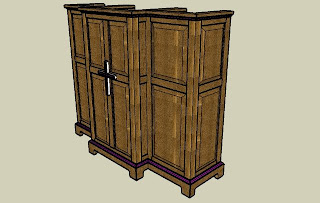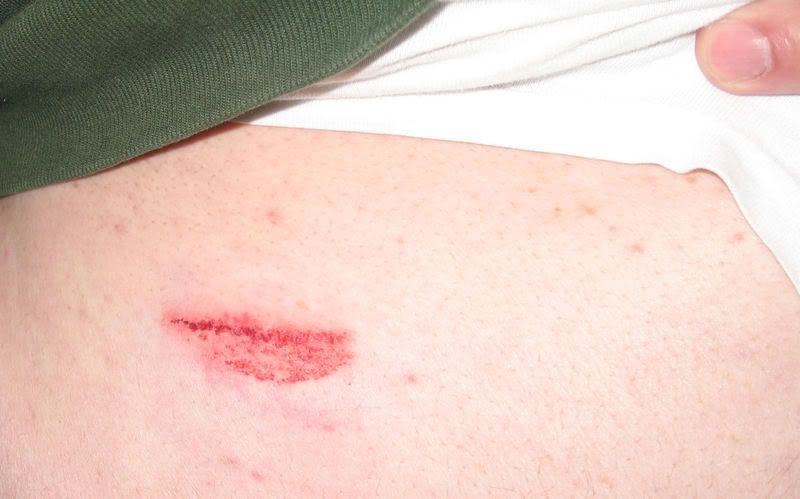My family & I have been going to Higher Ground Ministries in Danbury, CT for almost a year now. Our pastor has this pulpit which she was given by another pastor when the church opened. The pulpit was made from a sheet of 1/2" plywood & was not very well made. It was functional, but I don't believe I've actually seen her stand behind it & deliver a sermon.
Back in March, I asked my pastor if I could make a new pulpit for her, and she agreed. So began a three week period of designing a new piece in between church, work, family obligations, and actually making progress on the corner cabinet.
I started by researching pulpits on the Web. My first attempt was based upon a web site I found where the author built a lectern & documented what they did. It was intended to be portable for use in demonstrating products in super markets, but I figured it was a good starting point. I showed that to my pastor & she liked it, but she wanted it to be bigger with wings off to the side. So it was back to SketchUp for another attempt.
The following pictures show what I finally came up with. When I did these drawings, I "painted" everything to give the best impression of what the finished product would look like. Pastor has signed off on this design, so it is what I will be building.
The image above shows a 3/4 view of the pulpit. It will be made primarily from solid plain sawn red oak. Plain sliced red oak plywood will be used to make 4 inner partitions and the shelves, except for the lectern shelf, which will also be made from solid red oak. The moldings will be made of purple heart and hard maple as a trim. This purple heart & maple motif will be repeated in the cross decorating the front.





 The image on the left is a front view of the pulpit. The image to the right is a side view, while the picture below left shows the pulpit from the rear and the one below right shows the lectern, from the view point of someone standing behind the pulpit. The last two pictures show the molding details.
The image on the left is a front view of the pulpit. The image to the right is a side view, while the picture below left shows the pulpit from the rear and the one below right shows the lectern, from the view point of someone standing behind the pulpit. The last two pictures show the molding details.
When finished, the pulpit will consist of three separate units that will be bolted together. I'm building it this way because the finished unit wouldn't fit in my mini-van without being able to break it down.
The central unit will be 24 1/2" at the widest and 19 1/4" deep; the two wings will be 16 1/2" at the widest and 14 3/4" deep. All three units are 48" tall. I used the Golden Ratio when determining the dimensions in an attempt to make the proportions as pleasing to the eye as possible.
The top & bottom shelves in all three units are fixed & help keep the units square. The other three shelves will be adjustable using shelf pins. The unit will be free standing, so everything will stand on adjustable feet so it can be leveled & kept from rocking. And the lectern will be removable, so a laptop can be put on the center top shelf & used to reference notes.
Lastly, here's a close-up of the cross on the front.
The cross will be made from a 1/4" ply backer cut into the shape of the cross. Pieces of purple heart approximately 1/2" thick (a little more to make up for the 1/4" ply's thickness being less than 1/4") will be mitered, cut to length, and glued to the backer. I'll probably use 1/2" pin nails through the backer into the purple heart to help hold everything together "while the glue dries." Lastly, 1/4" thick by 3/4" wide maple will be mitered & wrap the purple heart. This will then be screwed onto the front. The screws will be driven from the inside through the front & into the back of the cross.
As for finish, all of the purple heart & maple will be covered with a coat of shellac as a seal coat & to keep the stain from affecting the color. The red oak will be stained with golden oak stain to match an existing red oak piece in the Sanctuary. The whole thing will then be finished with water borne polyurethane to keep the color from changing & provide the protection the piece will need.
It's my intention to put a power strip in the pulpit to power a lamp that will be attached to the centere front cap rail and any laptops that are used with the pulpit. I also want to attach a microphone support to the center right front corner. I'll have to cut a channel in one of the center front posts to run a power cord to the power strip.
Next time, another exhaustive list of steps needed to make this project.























